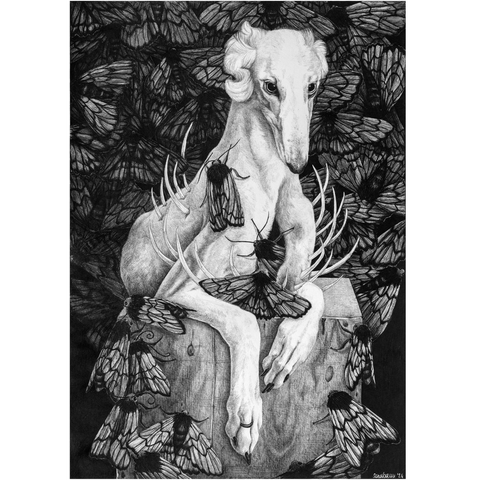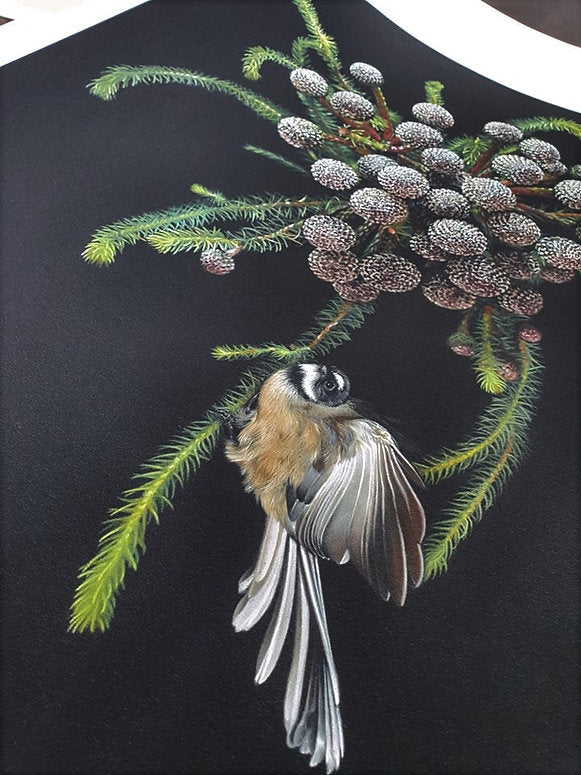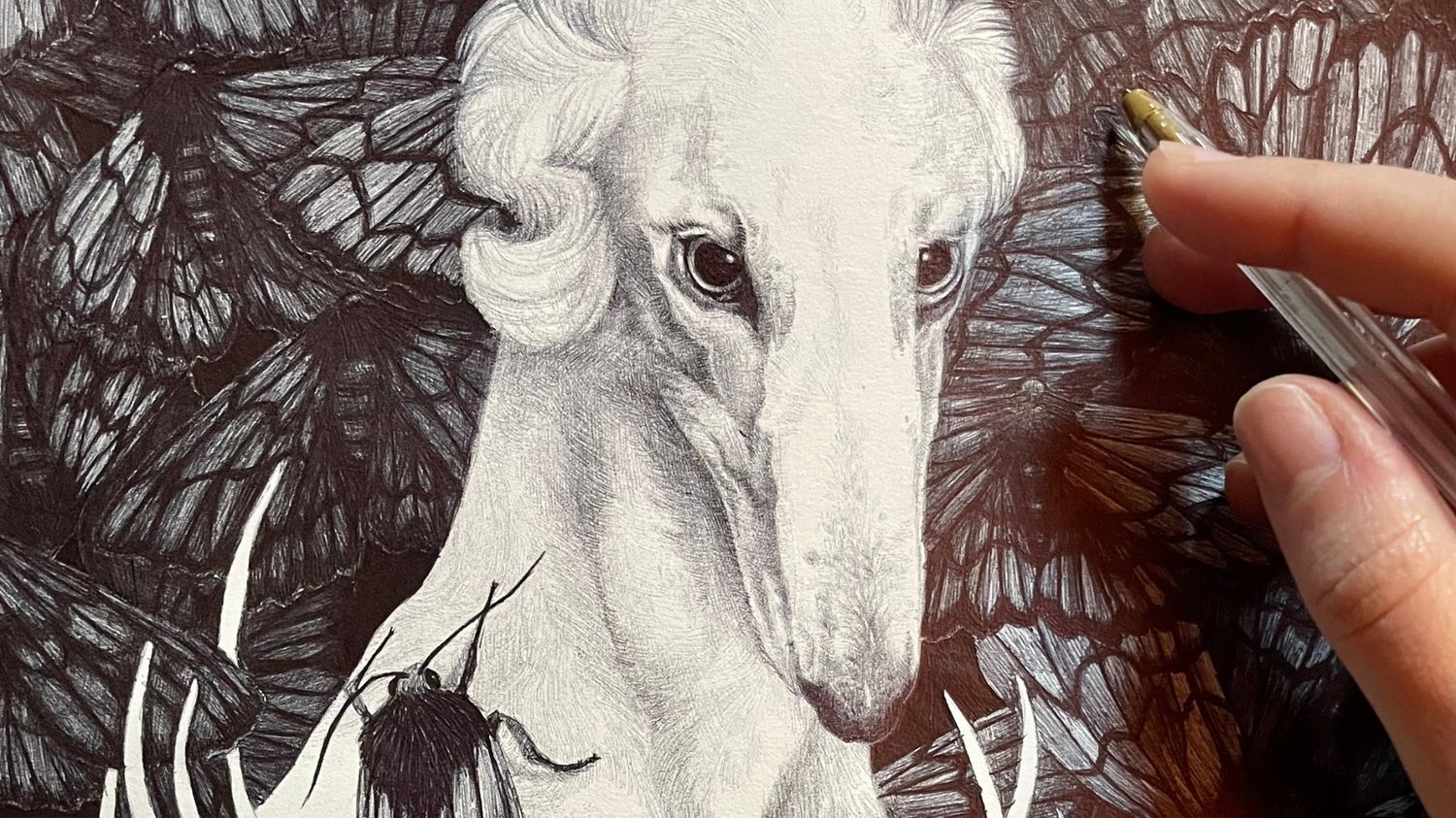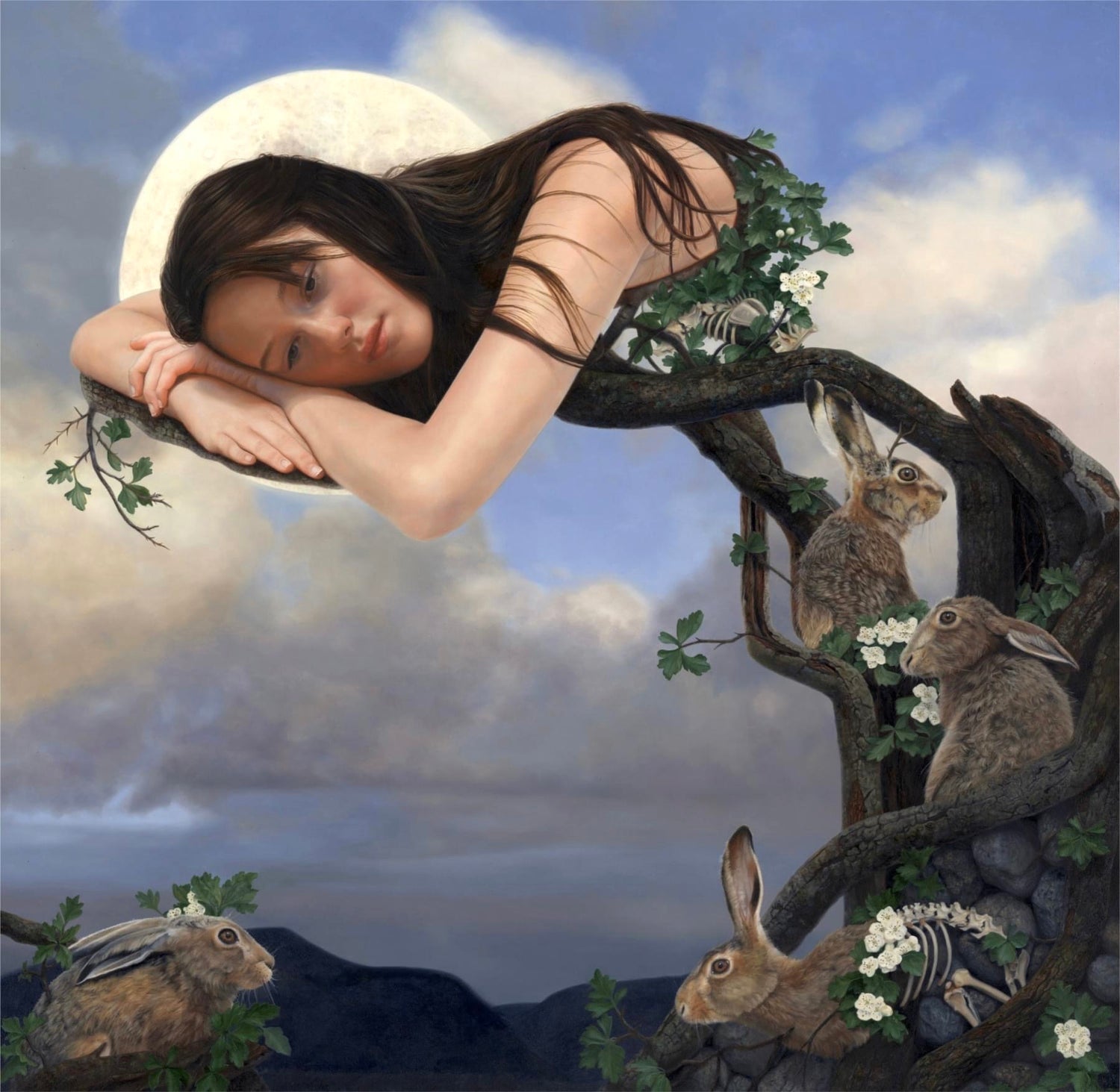By Elizah Leigh
“You can be brainwashed, or you can be ugly. There's nothing in between.”~ Barbie

Striving for physical perfection continues to be at the forefront of our collective minds, yet chasing after a wildly unattainable body has one notable side effect that can’t even be sugar coated because to do so would be a keto no-no - we’re insane to believe that human resplendence is the golden standard for aesthetic excellence! If we weren’t suffering from delusions of grandeur by way of severe carbohydrate deprivation, we might have the good sense to recognise the naturally flawless wild kingdom really deserves the top ‘beauty queen’ prize.
Of course, stereotypically pretty little dearies have long received the lion’s share of our ooos and ahhhs, which is why Sara Baun’s illustrative catwalk - filled with a creepy-cute array of ‘take me as I am’ oddballs - is a refreshing change of pace.
The much-loved dark surrealist’s enduring reverence for all creatures great and small - which took root in childhood and then burst forth in a riot of technicolor resplendence during her time as an injured wildlife rehabilitator – makes animals an obvious subject of illustrative exploration.
Rather than perpetuating the notion that fawning over flawless, cream-of-the-crop specimens is just as acceptable in art as it sadly continues to be in life, the Italy-born creative instead chooses to amplify the voices of her motley menagerie of toothy in-betweeners, all of them emblematic of those who society far too often ignores. Tattered twists, constricting coils and thorny thickets may attempt to squeeze the bejeezus out of Sara’s long-stifled beings, yet a rising cacophony of emotional liberation can be heard emanating in the distance.
Why does working within the realm of dark surrealism help you to more effectively explore concepts such as feeling lost in life and/or feeling chronically unseen?
There’s something about the drama and mystery of dark surrealism that charms me so much. I don’t want my art to be perceived as sad or make people feel hopeless, though. Ok, my drawings about struggling weirdos are sometimes sarcastic, super dramatic and a bit creepy, but my intention is for them to be positive. I always try to balance the dark with light, whether in the piece itself or in the title. I don’t question myself about my art that much, but working in the dark surrealism genre just feels right. Maybe I just find dark beautiful.
Is there a certain part of you that regards being a “weirdo” who creates “weird art” as a badge of honour?
Ahah…probably?
Let’s just say that sometimes being a “weirdo” who creates “weird art” feels hard and lonely, while at other times it feels special and cool. I wouldn’t say that I’m at the badge of honour stage yet, but I like what I do the way that I do it…most of the time. Overall, I’m proud of that.
Using the word “weird” isn’t meant to have a negative connotation, though. I think it’s a nice, quirky, and kind of funny way to define myself as a whole person, more than just as me as an artist. I wouldn’t change my “weirdness” for anybody else’s or vice versa.

Championing the misfits and underdogs of the world seems to be an important aspect of your creative output. When you call your illustrated characters ‘weird dark creatures’, isn’t that a term of endearment?
Yes, it is definitely a term of endearment to call my creatures ‘weirdos’. Consciously or not, perhaps I try to give human underdogs time in the spotlight since I believe that they kinda deserve it.
Considering your lifelong affection for animals and nature, do you think that integrating them into your art was inevitable, or did your time volunteering at a wild animal rescue centre truly solidify that visual direction?
Prior to my work at the wild animal rescue centre, I was actually interested in drawing people, so I really can’t be sure if I would have ended up drawing animals no matter what. But throughout my life, I’ve always had a crush on nature and wildlife, and my love for them only intensified once I was able see them up close, interact with them, and really bond with them. Birds were never really on my radar before, but once I got to know them, I fell in love.
On a deeper level, do you think that fans connect with your work because it’s evident that you have an affinity for living beings who cannot advocate for themselves?
Just reading the words “living beings who cannot advocate for themselves” makes me feel emotional, so I’d say yes, that’s an accurate observation.
You also say that your art is about vulnerability. Does the creative process of manifesting each new creature on paper help you to purge your own suppressed emotions?
It didn’t start that way, but last year while working with a therapist, I began putting more intention into using drawing as a vehicle for emotional release. I wouldn’t say that a weight is lifted with every piece that I create, but it surely helps me to process my emotions, with the goal one day of understanding and peacefully living with them.
In a somewhat similar vein, does including human teeth in your surreal animal portraits further reinforce your desire to offer your weird menagerie a platform to share what’s on their minds?
Somehow, I think that seeing their teeth is pleasing to the eye, plus I equate mouths with letting things out…speaking out loud when necessary…telling truths. My weird animals are finally venting, yelling, screaming, and making a bunch of noise after ages of keeping everything inside.

A major turning point in your journey toward self-understanding has been your relatively recent revelation that ADHD has shaped your formative years and beyond. What has that experience has been like for you?
I was always the quiet and shy kid who seemed to be just fine, but looking back with more awareness about the matter it seems obvious I have ADHD. It still seems impossible to me that nobody noticed - especially my teachers - however, there’s much more awareness about the disorder today than there was in the past.
Even without receiving a formal diagnosis from a doctor (which is very expensive in Italy), simply just treating myself as an ADHD person has improved the quality of my life so much. There’s so much room for improvement, which is enough for me.
In what way has that ‘ah ha’ moment impacted your art path?
It’s pretty cool that art keeps me super busy, but it also challenges me every dang day. There are so many things I crazily love about it, and other things that either test my patience or I really can’t stand. Despite the normal ups and downs in life, creating art definitely makes me feel more aligned. As time passes, it grows on me even more. But since my art path is in its infancy, I’m still trying to figure out the larger answer to that question.

Let’s talk art materials! Why is black ink your go-to pigment of choice?
There was a point when I needed to take a break from using colours, so I began drawing with just one material - a cheap black ballpoint pen. With time and lots of practice, I was amazed to see how many gradients of black and grey I could achieve through layers and pressure and textures.
I learned that using a brand-new stiff pen generates so many light shades of grey since the ink is only just beginning to “wake up”, whereas using a pen with barely any ink left in the barrel delivers much deeper blacks - it just flows a lot smoother.
I even discovered that mapping out my color scheme ahead of time – by literally labelling every part of my drawings with ‘dark…light grey…darker grey…just a dash of grey, etc.’ – helps me to achieve the right visual contrast between each element.
Rather than using “artist grade” drawing pens by the likes of Copic, Staedtler, etc., you reach for old-school Bic Cristal ballpoint pens time and time again. What makes that writing implement so appealing to you?
I love the artistic versatility of a simple Bic pen - I can achieve so many grey tones - whereas other ink pens made for artists don’t give me enough shading possibilities. I’ve tried various other Bic pen styles/options, too (gel ink, different line widths, etc.) but I inevitably returned to their simplest pen since I’m very picky about the results.
Do you have a concern that Bic ink may not have the archival qualities of other artist grade materials, or does that matter to you?
*Me googling ‘How many years does Bic pen ink last?’*
In addition to applying a protective spray fixative on my original drawings, I always include instructions on how to prevent images from fading, but you just unlocked a new anxiety that I didn’t have before ahaha.
Using indelible, unforgiving ink requires a certain level of artistic confidence, doesn’t it? Surely that flexes your problem-solving skills?
In the past, I tried so many other art materials before realizing that using ink gives me great results and so much control. Inking a piece is a very slow process, though, and apart from darkening areas to camouflage early-stage mistakes, revisions aren’t really an option.
If I really pay attention, I’m able to anticipate mistakes and figure out an alternate path - which is very satisfying - but being aware of the potential for mistakes stresses the heck out of me. With the pens that I use, leaks are always around the corner, so I have to remember to constantly blot the excess ink.
There are times when I leave mistakes in plain sight (since I realise that I’m the only one who notices them), but overall, I guess you learn how to work around “mistakes” when you can’t go back.
Are you rigid about pre-sketching your compositions prior to inking them, or is improvisation a part of your process?
Actually, my sketchbook is a pencil-free zone – I love drawing with pen, and if mistakes happen, I go over them or just leave them as is. When it comes to my formal works of art, though, I look at tons of reference images while drawing my composition with pencil, and then I ink everything in. I always stick with that very same process so I can prevent mistakes from happening.
When you say that a “mistake kills the concept”, do you actually abandon even your coolest sketchbook ideas simply because of an inking error?
Actually, I just lose interest. Since I constantly generate so many new ideas, there are times when I can’t wait to finish what I’m currently working on so I can move onto my next project. My brain refuses to think about starting something over again - that’s too boring – but if I still cared about an idea after many years had passed, I might be tempted to reinvent it in a different way.

Regardless of our career path, perfectionist tendencies can hamper our productivity rate, but surely any artist who leans into “the pain and suffering” of using a humble Bic pen isn’t able to be as prolific as they might like?
Yes, I surely am a perfectionist – help! I’m not terribly happy with the current volume of art that I create, but to some degree, that’s due to the amount of side projects that I pursue (and breaks, too). I’m sure I’ll establish more consistency in the coming months and years, though.
Since 2020, nineteen old-school Bic pens made the ultimate sacrifice for your art, which is a testament to the longevity and affordability of that unsung art medium. Since you freely share your love for that company’s product, have they ever returned the kindness by sending you some complementary goodies?
I tagged them a couple of times, and they even shared a compliment, but nope…that’s it. I guess there wasn’t a spark between us. *Heartbreak.* However, a few years ago, an Italian company sent me a couple of their stone paper sketchbooks to try, which I was very happy about it. Nobody else has reached out since then.
Do you intentionally purchase low-cost writing pens and sketch paper to prove that producing high caliber art is not dependent on top-of-the-line art materials?
No, I’m just poor. Doing crazy stuff with cheap materials makes me feel proud, though.

Considering your very large Instagram following, it’s hard to believe that you only began sharing your art on that platform in late 2019. In spite of the ever-frustrating algorithm and various other challenging factors, why do you think your work has still managed to reach so many art fans while other equally talented creatives are plagued with invisibility?
I really couldn’t be a full-time artist if it wasn’t for my Instagram following, so I thank the universe every day. Of course, using that platform a few years ago when it was still humanly possible to grow my audience helped my visibility a lot. Even though the bird series that I shared during Inktober 2020 – which ended up being my breakthrough – has its charm, it almost seems like a random stroke of luck…like I shared the right thing at exactly the right time.
You respond to a large number of comments on your Instagram posts. Why is that important to you?
I’d like to say that I’m super confident about what I do, but I’m not. Sometimes, seeing so many people out there who appreciate my art literally saves my day. Being “approachable” is important to me, so that’s why I always try to thank anyone who takes the time to give me a compliment. It’s funny that I have a very different perspective about direct messages, though. Just looking at that section gives me anxiety.
Could the fact that you’re able to ‘virtually’ hang out with your art posse on a daily basis - coupled with the artistic fulfilment that you’ve been experiencing in recent years - be why your self-described ‘socially uncomfortable’ self seems so chatty and bright online?
I’m social awkward in my day-to-day life, and I’m still in a place where I don’t feel totally safe yet, which makes me feel like I have to hide my awkwardness so the people around me feel more comfortable. Masking is exhausting - and I’m working on it - but being behind a screen makes socialising with others soooo easy.
You’re an ‘instant reward’ kind of person – which you attribute to a lack of patience – yet there have been times when you’ve worked as many as 100 hours on a single piece of art. Exactly what is the instant reward in your artistic practice?
There isn’t any instant reward!
I always compare drawing with a pen to being stuck in a toxic relationship. You don’t feel very good but trying to change what you’re already familiar with is actually super scary, so you end up staying in the exact same situation.
All kidding aside, in the very beginning of my art career, I had no proof that I’d end up getting great results by working hard and hanging in there. Slowly but surely though, I learned that huge rewards were absolutely possible.
Regarding instant rewards though, it may sound silly, but I got into the habit of concealing every part of a composition I’m inking - except for the section I’m working on in the moment – to trick my brain into thinking that the larger sized pieces I work on are much more manageable.

On the opposite side of the spectrum, what do you think is the most unrewarding thing about being an artist?
Since I’m an anxious soul, the most unrewarding aspect of being an artist is definitely the uncertainty. There are times when I have to tap into all of my rationality and nerve just so I don’t crumble into pieces. Bolstering my heart with the encouragement of my loved ones - who have always believed in me - also makes a huge difference. Hopefully I’ll get accustomed to the rollercoaster ride of this career path…that would be nice. (*Or maybe I’ll end up becoming rich, which would also be nice!*)
How do you know when it’s officially time to step away from a work of art once and for all?
When I’m just a few hours away from totally completing a piece, I can feel the anxiety and the impatience in my hands. I get caught up in the rush of officially wrapping it up because my mind has already planned in great detail the next three pieces that I’m going to work on!
Has navigating this relatively new artistic path - while metaphorically enabling the struggling weirdos of the world to feel seen and heard – helped you to find your own comfy-cozy place in this world?
I can’t imagine myself doing anything else. It’s not easy - there are a lot of taxes and handling everything can be overwhelming, but I am certain that this is the right path for me. It’s hard to be bored in this profession when your brain is exposed to so much stimuli. Everything is challenging in a good way, and I love the fact that there’s so much room for me to explore the depths of my creativity. There are so many things that I’m still dreaming of and hoping to improve, but - even with ups and downs - I’m happy with where I am in this moment.





